

Home/Active Page
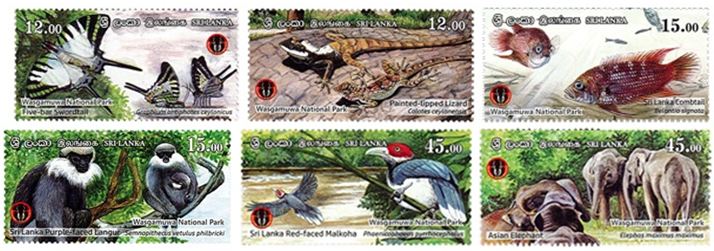
The Philatelic Bureau of the Department of Post has issued six new postage stamps in the denominations of Rs. 12.00, Rs.15.00 and Rs.45.00 with six souvenir sheets on 05 October 2019 as the seventh issue in the ‘National Parks of Sri Lanka’ series, depicting the images of six animals that inhabit the Wasgamuwa National Park.
| Date of Issue | 5th of October 2019 |
| Denomination | Rs.12.00 x 2, Rs.15.00 x 2, Rs.45.00 x 2 |
| Catalogue No: | painted-lipped lizard - CSL 2336 Sri lanka Combtail - CSL 2337 Sri Lanka Red – faced Malkoha - CSL 2338 Five Bar Swordtail - CSL 2339 Sri Lanka Purple – faced Langur - CSL 2340 Asian Elephant - CSL 2341 |
| Stamp Designer | Kelum A Gunasekara | Stamp Size: | 60mm x 30mm |
| Sheet Composition: | 20 stamps per sheet |
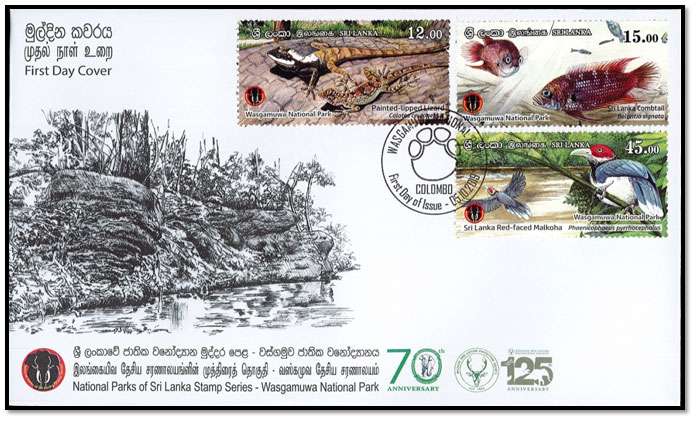
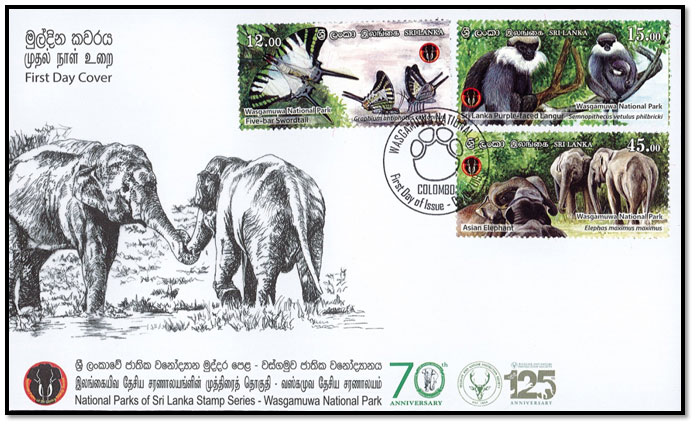
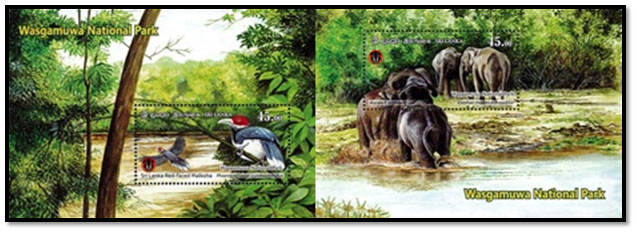
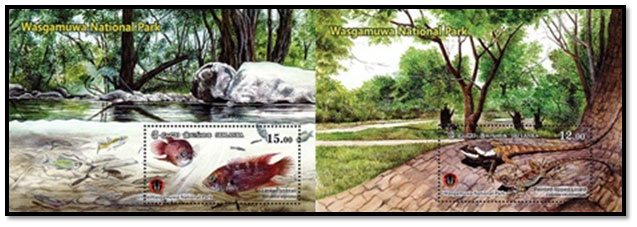
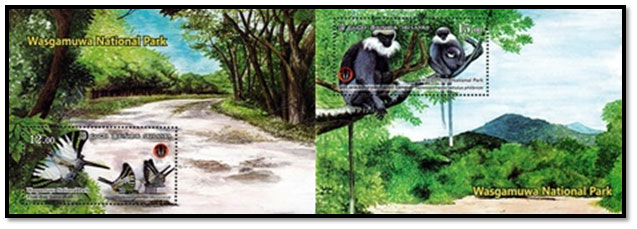
The Philatelic Bureau of the Department of Post has Issued six new postage stamps in the denominations of Rs. 12.00, Rs.15.00 and Rs.45.00 with six souvenir sheets on 05 October 2019 as the seventh issue in the ‘National Parks of Sri Lanka’ series, depicting the images of six animals that inhabit the Wasgamuwa National Park.
It is the belief of some that the name “Wasgamuwa” derives from Sinhala ‘Walas Gamuwa’ where ‘walaha’ means bear and ‘gamuwa’ means the woods. The Wasgamuwa National Park is situated in the Matale and Polonnaruwa Districts bounded by the Mahaweli river, Sudukanda range, Amban river and Dunvil Oya on the East, West, North and South respectively. The Park, which covers an area of approximately 37,062 hectares was declared a National Park on 07 August 1984. The Wasgamuwa National Park is known as the park that came into being as a result of the efforts made to create greater forest coverage for the wildlife deprived of their homelands as a result of the Accelerated Mahaweli Development Project. In addition to the Mahaweli river, the rivers Amban Ganga and the Kalu Ganga also flow through the Park. Towards the South of the Park, the deep waters of the Dunuwil Oya flows wide over the land.
The Park consists of a variety of ecosystems including primary forests, secondary forests, riverine forests and grasslands. The Sudukanda range is the most unique biodiversity zone in the Wasgamuwa Park. Springs that reach the surface in this area feed the water sources that flow in and around the Park. Around 23 species of mammals that inhabit Sri Lanka can be found in the Wasgamuwa National Park. Elephants are a major feature among them. Wasgamuwa National Park stands unique as the national park in the Central province where one could observe elephants in their natural habitat. The population of elephants inhabiting the Park is around 100-150. In particular the Park is popular for herds of marsh elephants. Marsh elephants that roam the river areas enjoying the grass that grow in the aquatic ecosystem are a unique feature that can be observed in the Park. In addition, the Park is home to 143 bird species, 17 reptile species, 08 amphibian species, 17 fish species, 50 butterfly species as well as 150 species of flora, boasting of an astoundingly wide biodiversity.
The painted lipped lizard is a valued member of lizard families endemic to Sri Lanka. The brightly colored upper lips of the male lizard has given this species their unique name. The male has distinctly white strip on its upper lip. When changing color, the lizard takes shades of black, white, green and red. Using these color changes the lizard blends into its habitat displaying unique abilities to camouflage itself. These tree-dwellers find sustenance using the colors that nature has gifted them. The painted lipped lizard would stand on the trunk of a tree, change the color of its lips to bright red and sway its head from side to side, mimicking the sway of a flower in full bloom, swaying in the wind. With this, the lizard is able to attract a variety of insects who fly close to its mouth and even land right next to its mouth having been deceived by the flower-like appearance. The female lizard is of a darker color when compared with the male. These lizards prefer to live independently on trees and separated on the basis of gender. They are not habituated to human contact hence it is very difficult to observe them in their natural habitat. Oftentimes, if a lizard is spotted on a tree, it is likely that the observer will have to go around the tree to get a closer look at the lizard as it is likely to hide itself by moving here and there on the tree.
The Combtail is a colorful fish endemic to Sri Lanka. The vibrant red color on its body can be observed clearly as it swims in natural and regular surroundings. Whenever the combtail is agitated, the red color observed on its fins will become more subdued. The combtail prefers slow moving waters of dark and shadowy ponds created in streams. A fully grown combtail grows to be 18-20 cm. An identifying feature of this fish is the extension of the rays of the caudal fin beyond the web of the fin. The combtail displays aggressive tendencies among other fish in its natural aquatic habitat. It swims in the lower stratum of the water and prefers to keep its dwellings in sight as it moves about in order to defend it from any unfamiliar fish swimming into its territory. The combtail gives priority to defending its territory by displaying aggression towards other fish. It prefers to feed on small insects that float on water.
Fitting its name, the Red-faced Malkoha has a crimson red band around its face. The crimson-red face is not bare, but composed of short, bristly hair-like feathers. This makes the species extremely distinctive. Its bill is apple green while the forehead, nape, chin, throat and chest appear blackish green. The white flecks starting at the head reach all the way down to the nape. Its underbelly is white. The wings, back, lap and upper-tail are black and appear glossed with metallic green upon closer inspection. The tail has a base tinged with white. Feet and legs are a mix of blue, black and slate blue. Although the male and the female appear similar in plumage, irises are colored differently. The male has a brown iris while the female has a while iris. Juveniles have a darker irises. In pairs, the larger bird is the female while the male appears smaller in size when compared with the female. The red-faced Malkoha can be observed in pairs, alone or in small flocks. During mating seasons, they can be observed in groups, collectively protecting their nests, eggs and the young. Although this bird belongs in the cuculidae family or the cuckoo family, this species is not a brood parasite. Therefore it builds its own nests for breeding. The nest which appears untidy, is built using twigs, tree roots etc. The red-faced malkoha breeds twice a year. First mating season is from January to March while the second mating season of the year is from August to October. The female lays 02 to 03 white eggs with reddish surfaces.
This incredible butterfly belongs to the Papilionidae family. The forewing has the cell crossed by five bars, while the hind-wings extend into a sword-like shape, giving the butterfly its name 'five bar swordtail.' According to the red data book, the five bar swordtail is an endangered species and can be identified as an extremely rare butterfly species reported in Sri Lanka. Semi-evergreen forests in the intermediate zone, such as the Wasgamuwa National Park which have the characteristics of both wet and dry zones are ideal habitat for these butterflies to flourish. Since sufficient studies have not been carried out on this butterfly, only limited information is available on its life cycle. The female five bar swordtail lays eggs on trees belonging to the Annonaceae family. Male Five Bar Swordtails are often observed puddling at muddy seepages and along dried-up river banks in order to fulfill their mineral requirements.
Sri Lanka purple faced langur is a species of monkey endemic to Sri Lanka. It is a species identified as endangered. Well-built physique of these animals with pelage taking shades between back to grayish brown. They prefer to live in groups. Leadership of these groups are usually claimed by a fully grown male. The leader claims rights to the female langurs in the group and the genetic make-up of the future generation of monkeys. Other males in the group may lay claim to it only as long as they do not challenge the leadership. Sri Lanka purple faced langurs communicate using loud calls. Vocalization can be used to alert members of predators, attract mates, defend territory from other groups of monkeys and to inform others of the territory dominated by the group. These monkeys are mostly folivorous but will also feed on fruits, flowers, and seeds. Since leaves are their staple food, they have a specialized gut with bacteria that can digest mature leaves. When this arboreal species perch on trees maintain their tails inclined towards the ground. Depending on the length of their tail, several subspecies can be identified. There are four such subspecies in Sri Lanka. They are namely, the Semnopithecus vetulus vetulus reported from the wet zone to the South of Kalu Ganga, Semnopithecus vetulus nestor reported from the Western zone to the South of the Kalu Ganga, Semnopithecus vetulus philbricki reported in the North Central Province and the Semnopithecus vetulus monticola reported in areas between 1200m and 2200m from sea level. In addition to that Semnopithecus vetulus harti reported in Deniyaya and Lankagama is also proposed to be identified as another subspecies.
The Asian elephant can be found in 13 Asian countries including Sri Lanka. The Asian Elephant is an herbivorous mammal that inhabit grasslands, tropical evergreen forests, semi-evergreen forests, moist deciduous forests, dry deciduous forests and dry thorn forests, in addition to cultivated and secondary forests and wetland forests. They display seasonal migration patterns based on their food. These elephants prefer to stay among tall grass and use the toes of their front legs to kick and loosen the grass which they consume. They consume approximately 170-220 kilos of vegetation daily while they require approximately 70-130 liters of water per day. At present, the Asian elephant faces serious challenges in terms of survival due to the decline in their habitat and fragmentation of forests. The Flora and Fauna Ordinance of Sri Lanka has listed the elephant as a highly protected mammal.
All rights received. All right to identify the Department of Posts as the Author and designer of this Bulleting has been asserted in accordance with the Copyright, Design and Patents Act 1988.No part to this publication may be reproduced, stored in or introduced into a retrieval system, or transmitted in any form or by and means (electronic, mechanical, photocopying, recording or otherwise) without the prior permission from the publisher. Any person who does and unauthorized act in relation to this publication may be liable to criminal prosecution and civil claims for damages.)